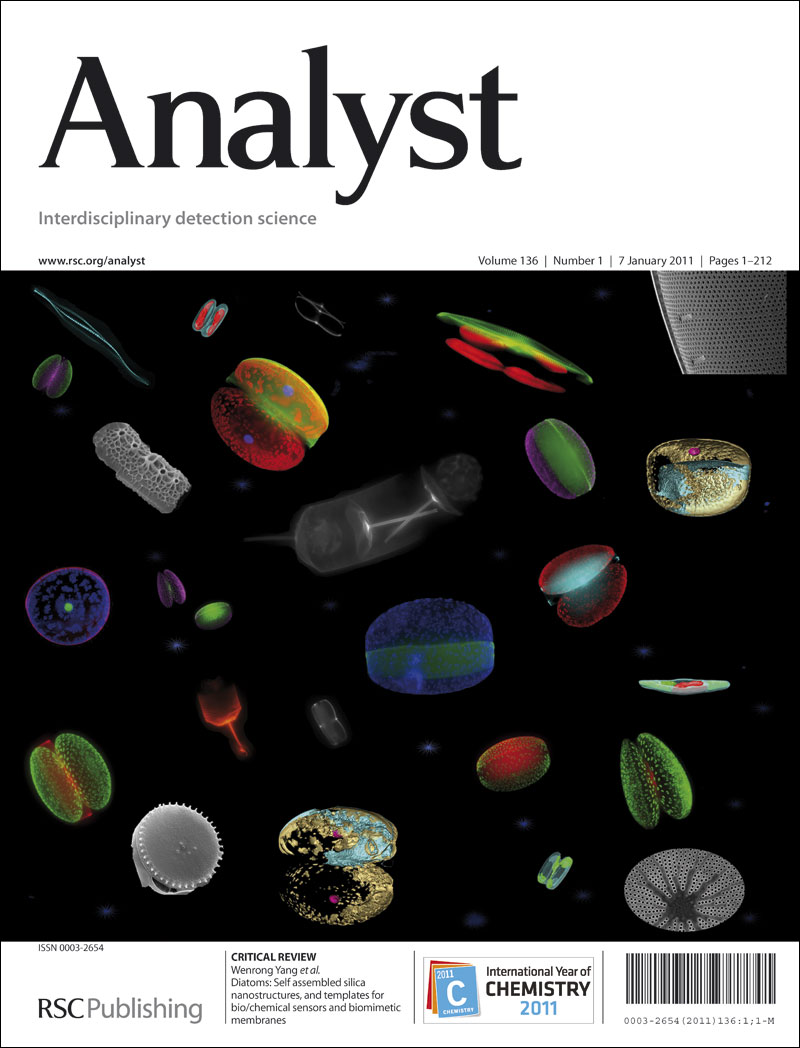检测稀土元素离子的双探针荧光传感器阵列
IF 3.6
3区 化学
Q2 CHEMISTRY, ANALYTICAL
引用次数: 0
摘要
由于稀土元素离子对人类健康和环境的影响,一直需要有效的传感器来探测稀土元素离子。因此,一种简单高效的荧光检测reis的方法,提供方便、灵活、多功能性和高效率,对于确保环境安全、食品质量和生物医学应用至关重要。本研究利用6-氮杂-2-硫胸腺嘧啶-金纳米簇(at - auncs)和牛血清白蛋白/3-巯基丙酸- auncs (BSA/MPA-AuNCs)检测14种reei (Sc3+、Gd3+、Lu3+、Y3+、Ce3+、Pr3+、Yb3+、Dy3+、Tm3+、Sm3+、Ho3+、Tb3+、La3+、Eu3+),建立了一个简单、灵敏、多靶点的荧光传感器阵列检测平台。我们观察到REEIs对at - auncs和BSA/MPA-AuNCs具有不同的增强或淬灭作用。因此,这两个探头作为双信号通道,不同效果的reei作为信号输入。采用层次聚类分析(HCA)和线性判别分析(LDA)等模式识别方法对构建的传感系统的识别性能进行了评价。除了识别单个REEIs的出色能力之外,该平台还能够识别混合REEIs。此外,将该方法应用于纯净水样品中的REEIs检测,验证了该方法的有效性。该方法不仅最大限度地减少了合成和优化新探针的需要,而且为多种分析物的测定和鉴定提供了一种新的方法,填补了同时检测大量reei的空白。本文章由计算机程序翻译,如有差异,请以英文原文为准。
Double Probes-based Fluorescence Sensor Array to Detect Rare Earth Element Ions
There is a persistent need for effective sensors to detect rare earth element ions (REEIs) due to their effects on human health and the environment. Thus, a simple and efficient fluorescence-based detection method for REEIs that offers convenience, flexibility, versatility, and efficiency is essential for ensuring environmental safety, food quality, and biomedical applications. In this study, 6-aza-2-thiothymine-gold nanoclusters (ATT-AuNCs) and bovine serum albumin/3-mercaptopropionic acid-AuNCs (BSA/MPA-AuNCs) were utilized to detect 14 REEIs (Sc3+, Gd3+, Lu3+, Y3+, Ce3+, Pr3+, Yb3+, Dy3+, Tm3+, Sm3+, Ho3+, Tb3+, La3+, and Eu3+), resulting in the creation of a simple, sensitive, and multi-target fluorescence sensor array detection platform. We observed that REEIs exert various enhancement or quenching effects on ATT-AuNCs and BSA/MPA-AuNCs. Thus, these two probes function as double signal channels, with the different effects of REEIs serving as signal inputs. Pattern recognition methods, including hierarchical cluster analysis (HCA) and linear discriminant analysis (LDA), were used to assess the recognition performance of the constructed sensing system. Beyond the excellent ability to recognize individual REEIs, the platform is also capable of distinguishing mixed REEIs. Also, this approach was validated by applying it to detect REEIs in purified water samples. This method not only minimizes the need for synthesizing and optimizing new probes but also offers a novel approach for the determination and identification of diverse analytes, filling a gap in the detection of a large number of REEIs simultaneously.
求助全文
通过发布文献求助,成功后即可免费获取论文全文。
去求助
来源期刊

Analyst
化学-分析化学
CiteScore
7.80
自引率
4.80%
发文量
636
审稿时长
1.9 months
期刊介绍:
"Analyst" journal is the home of premier fundamental discoveries, inventions and applications in the analytical and bioanalytical sciences.
 求助内容:
求助内容: 应助结果提醒方式:
应助结果提醒方式:


